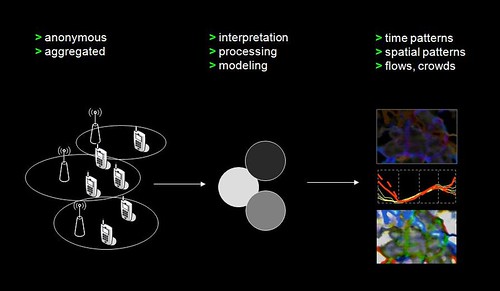Wednesday Sept. 24 I went to one of the sessions at PICNIC ’08 called “The Visible City”. This session was about ways of visualizing mobility patterns in the city. From the announcement:
What if an entire city could be visible from above, like we see it from an airplane? Not simply buildings and squares, but also the aggregation of people who populate it, outdoor as well as indoor. We could detect public gatherings and traffic jams, estimate which neighborhoods are most crowded, reconstruct commuting patterns during the day. All sorts of new services for the public good would be enabled, from emergency planning to traffic management, from the efficient allocation of utilities to impact assessment of new city infrastructures.

Assaf Biderman, assistant director of the Senseable City Lab of MIT Boston, showed a number of projects. Realtime Rome uses aggregated data from cell phones of pedestrians, buses and taxis to visualize Rome’s urban dynamics in real time. Another project Assaf showed was New York Talk Exchange. This project “illustrates the global exchange of information in real time by visualizing volumes of long distance telephone and IP (Internet Protocol) data flowing between New York and cities around the world”. It shows the interconnectedness of cities worldwide. In a NY neighborhood with many Koreans for instance most foreign calls are made to south-Korea.
The second talk by host Euro Beinat – Director Sensible Future Foundation & University of Salzburg – was about the project currentcity.org. This project aims to make the city “visible from above” (just like BBC’s “Britain From Above“). In this project the city of Amsterdam is mapped and visualized using mobile phone telcom data.

(img source: currentcity.org)
After this presentation I posed the question “where are the people?” (using Christian Nold’s phrase in his presentation at The Mobile City ’08). These projects are all based on quantitative data: how many calls are made in what quadrant of the city? The important question that is left out seems to be how people subjectively experience and ‘write’ the city. Peoples’ mobilities are reduced to mere movements without meaning. From these projects it is very hard to get a sense of the city as a lived space. Except for NY Talk Exchange the emphasis in these projects is mostly on people’s physical mobility. Of course these are the easiest to represent visually. Yet it would be interesting to think about visualizations of other types of mobilities (e.g. imaginary and virtual mobilities). Another point I think is important to keep in mind is that these new types of visualizations are not neutral in their language. They convey a sense of spectacular high-tech futurism, as if (technologically mediated) mobility is only something very modern. The question I find truly interesting is how are ways of visualizing and mapping the city’s mobility patterns reflexively shaping urban culture and identities? Are we going to experience the city and our own roles as urban inhabitants in another fashion when we see such representations of the city and become used to them?
The third talk by Bart Schermer – Partner Considerati & University of Leiden – was about the privacy aspects that occur in the increasingly sentient city. The speaker showed what a complicated concept privacy actually is. Broadly speaking privacy in the public domain refers to the right to be not known to institutions (particularly the state). Privacy in the private domain refers to the right to be left alone there and not to be bothered by unwanted intrusions. A complicating factor is that although we value privacy at the same time we are putting all kinds of private information about ourselves online, visible to others in the public domain. Schermer argued for a discussion and reformulation of what kind of privacy we want to protect and maintain. He said that institutions and companies that address people via urban screens, bluetooth advertisements, or any kind of software-based system should “provide benefits for consumers”. Such a formulation is exactly part of my sense of unease about these kinds of developments: I dont want to be addressed as a consumer all the time in the public domain. I don’t want to have to balance benefits against possible intrusions into my privacy, and constantly make consumer choices. The issue is perhaps not so much protecting the freedom that we can choose to engage in these systems or refrain from them but the fact that we have to choose.
The final talk by Lorenzo de Rita – Founder and Chief Scientist of The Soon Institute (what, no website?) – was a future vision of how the world looks alike in 2020. It was an entertaining presentation of a number of scenarios that could become reality in the near future. Quite a few tended towards dystopian views: a soldier cutting out his RFID implant, a newly born baby having a tag sewn in after his umbilical cord is severed, etc.
